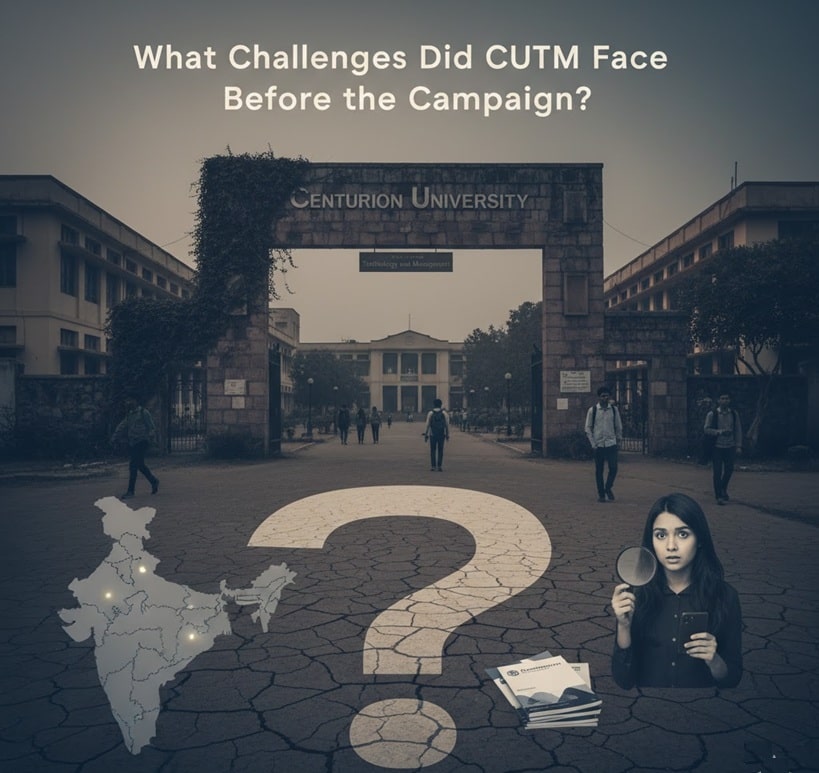Considering that the competition is so tough, the use of digital marketing is a must-have weapon for universities that are willing to attract and enroll the best students. The education sector in India is highly competitive, especially in the states like Odisha. In a world where digital comes first, a lot of schools are trying to get kids’ attention. Universities need to do more than just traditional marketing. They need to build a powerful online presence, ensure that their digital touchpoints are user-friendly, and also make sure that the entire process from knowing a school to signing up is easy and fast.
The case study elaborates the journey of Centurion University of Technology and Management (CUTM) turning a challenge into a victory by collaborating with Plan D Media to enhance its online presence. The university, due to its comprehensive, multi-channel digital approach, has been very successful in lead generation, student engagement, and enrolments. Besides this, the university has also positioned itself as a leader in strategic digital marketing in its domain.
About Centurion University – A Quick Overview
Centurion University of Technology and Management (CUTM), Bhubaneswar, Odisha, is focused on making students employable and encouraging them to become entrepreneurs rather than just giving degrees. They are recognized for their contributions to the development of sustainable lifestyles and have been acknowledged at the national level.
For instance, CUTM’s School of Vocational Education & Training was officially recognized as a “Centre of Excellence” by the Ministry of Skill Development & Entrepreneurship thus, the only university in India to get that honor.
But, their online game wasn’t as strong as their real-world efforts. That’s where Plan-D Media came in to help.
What Challenges Did CUTM Face Before the Campaign?

Centurion University was facing some issues with their digital marketing and website:
Paid ads were only getting about 20 leads each month from their ad campaigns, and they were paying a lot for each lead. The ads themselves weren’t great, which hurt results.
Website Traffic was a mystery. It was hard to tell where their website traffic was coming from. Plus, the site had some technical problems including difficulty functioning in mobile phones.
Social media was mostly random posting: posts generated only 4–5 engagements on average, there was no monthly calendar, and no competitor benchmarking or brand guidelines.
Lead nurturing and automation were virtually non-existent. There was no good tracking of the user journey, the admissions team couldn’t accurately calculate ROI of digital spend, and the flow from digital lead to walk-in was poorly managed.
In short: high cost, low output, poor optimisation, and no real system for conversion.
Plan D Media’s Digital Marketing Strategy for the University
Plan D Media came up with a thorough plan that went beyond numerous digital channels and touch-points.

1. Performance Marketing – Google Ads for Lead Generation
They launched very well planned Google Ads campaigns which were aimed at the use of keywords related to engineering and university admissions.
These campaigns were organised with proper ad groups and weekly monitoring of metrics like cost per lead, ad quality, landing page relevance, negative keywords, and bid models. Demographic and geo-targeting, vernacular ads were used to reach rural segments and landing pages were designed for high relevance to improve quality score. Weekly reviews and changes were normalised to improve click-through rate and conversion rate.
2. Search Engine Optimization (SEO) and Content Marketing
Determining the proper keywords to target: Utilizing tools and reviewing competitors’ work manually to arrive at the right keywords that were really going to drive conversions.
Updating the website: Altering page meta tags, transcript content headers, and managing content, as well as sending routine technical checks to correct anything that was slowing the site down or wasn’t viewable on mobile-friendly screen devices.
Acquiring links and organizing content: Drafting and posting regular blog posts on subjects relevant to students, acquiring links from high-traffic websites, engaging in competitor link acquisition strategies that worked well for them.
Content Optimization: The team agreed upon an excellent content calendar filled with informative education blog entries, program presentations, student success stories, and articles related to career advice. Each entry was a keyword optimized with the fundamental intention of offering students and their parents exceptional content value.
3. Google Maps / Local SEO
* Google My Business: Check your information, add cool photos and videos, get local links, and ask students to write reviews.
* Local SEO: Helps students find schools nearby.
4. Social Media Marketing
* Content plan: Schedule posts about why to attend college in Odisha and how it helps your career.
* Targeted ad campaigns on social media to get the word out and get people involved.
* Talking to followers, answering questions, and creating posts that encourage interaction to build a community and get more views.
5. Website Review and Conversion Optimisation
*We did a full website review and audit, then redesigned the pages as per UI (User Interface) and UX (User Experience).
*Fixed the all on-page issues like broken links, slow loading speeds, and mobile responsive issues.
*Adding inquiry forms, call-to-action buttons, and chat support.
*Integrating analytics and conversion tracking tools
6. Lead Care
* We set up email campaigns to send useful content, offers, and news based on lead interests.
* Marketing tools were added to sort and manage leads and send follow-up messages.
* The admissions staff made calls and sent messages to help students with enrollment questions.
7. Competitor Analysis
Plan-D Media analyzed the competitive landscape of the major universities in Odisha such as KIIT University and Siksha ‘O’ Anusandhan, etc. The research pointed out that although these institutions enjoyed solid brand recognition, their digital engagement levels were only average. Also, compared to Plan-D Media’s work for CUTM, they were not as detailed in targeting and optimizing their paid advertising strategies.
What were the main factors that made the digital strategy of Centurion University so successful?
• Very tightly targeted ads in the local language that reached villages and remote areas which were almost totally ignored by competitors
• Weekly optimization cycles instead of monthly reviews as done by other institutions
• The smooth integration of the lead nurturing system with admissions workflows that connected digital touchpoints
• Expertise in local SEO through very targeted Google My Business optimization and review generation
Results and Achievements
Centurion University saw very solid results from this overhaul:
A 40% increase in quality leads through the improved Google Ads + SEO efforts. The data revealed that Centurion University of Technology and Management had 50% more interactions on social media than other universities of similar size and that they had a 35% better cost-per-lead for paid campaigns, thus, confirming their strategy’s effectiveness.
A 30% increase in local inquiries and visits, thanks to better Google Maps ranking and local optimisation.
Social media engagement jumped by 50%, with meaningful growth in followers and interactions.
Website traffic increased by 25%, and lead conversion rate from the website improved by 20% following the technical & content audit.
Our nurturing strategy boosted lead-to-customer conversion (paying students) to 60%.
Total sales from online channels went up by 35%, really helping their revenue grow.
Here’s what we learned and what works best:
Don’t just use paid ads: If you skip things like organic SEO, local optimization, and a solid website, paid ads will cost you more and won’t work as well.
Organization is key: Break up your campaigns, tag your ad groups, and check in weekly. This cuts down on the cost per lead and gets you better conversions.
Tech setup helps growth: You need a website that’s fast, mobile-friendly, easy to use, and technically sound for good online results.
Good content + links = more organic traffic: Blog posts, looking at competitor backlinks, and getting links from high-authority sites will boost your domain authority and organic traffic over time.
Local SEO still counts: Even universities need to think local. People google things like “college near me” or “engineering college in Odisha.” Improving your maps and Google My Business will help more people to find you through their offline visits.
Lead nurturing is what makes the funnel complete: Generating leads is only half the job – up to follow, segmentation, automation, personalization communication should be there to convert leads into enrolled students.
Measurement & Optimisation: Always try to see the ROI, be on the lookout for the metrics (CTR, quality score, conversion rate, etc.) and make your changes to improve your work.
Conclusion – Get ready for Digital Education Success
Centurion University of Technology and Management (CUTM) and Plan-D Media show how a good digital plan with paid ads, SEO, local SEO, social media, website improvements, and lead nurturing can change how students get into a school. By focusing not just on leads, but on quality leads, and by building a system that carries them all the way to enrolment, the university was able to turn digital spend into measurable business results.
If you’re involved in higher-education marketing (or any sector where lead generation, local presence and digital conversion matter), this case is a strong model to study.





